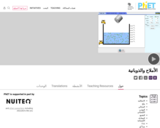
Formative Assessment - Investigate and analyze function families - Just in Time Quick Check, Teacher Notes, and Supporting Resources
- Subject:
- Mathematics
- Material Type:
- Assessment
- Lesson Plan
- Provider:
- VDOE
- Author:
- VDOE
- Date Added:
- 10/07/2024

Formative Assessment - Investigate and analyze function families - Just in Time Quick Check, Teacher Notes, and Supporting Resources

Students break apart cell phones to determine what elements are located in cell phones. They then use the elements to determine how the flow of electrons works in the cell phone. Lastly, create designs using legos to practice engineering practices that would be common in engineering.

Hands on Chemistry is a resource designed for use in traditional, online, and blended high school Chemistry classrooms. It was developed by Blue Ridge PBS in collaboration with Virtual Virginia. In this video, Chemistry teacher Fred Mitchell demonstrates the structure of atoms using simple models.
Keywords: shapes of atoms, electrons, elements, linear structure, sulfur dioxide, H2O, Hydrogen, Oxygen, lone pair, Ammonia, Nitrogen, Hydrogen, Sulfur Trioxide, trigonal planar, Methane, Carbon, tetrahedral, Phosphorous Pentachloride, trigonal bipyramidal
Meets VA SOL CH.3

Add different salts to water, then watch them dissolve and achieve a dynamic equilibrium with solid precipitate. Compare the number of ions in solution for highly soluble NaCl to other slightly soluble salts. Relate the charges on ions to the number of ions in the formula of a salt. Calculate Ksp values. Arabic Language.